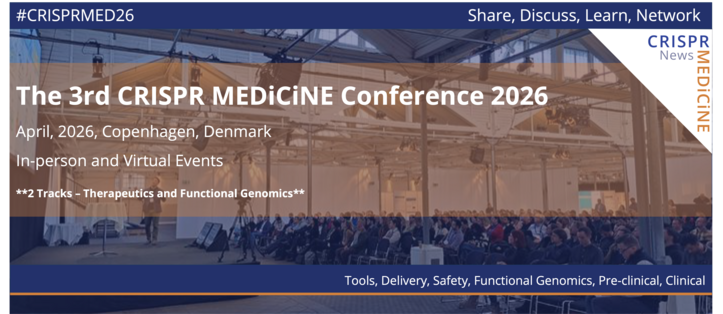Your Missing Links Are Here (23 April 2021)
By: Karen O'Hanlon Cohrt - Apr. 23, 2021
Top picks
- Beam Therapeutics published new data describing modifications to the traditional base-editing architecture to develop so called next-generation base editors, which can directly and precisely modify the pathogenic mutation in sickle cell disease (SCD). This advance provides hope for the development of autologous base-edited cell therapies for SCD. The findings were published in CRISPR Journal this week.
- Researchers in the US design a new CRISPR strategy ‘Co-opting Regulation Bypass Repair’ (CRBR), which unlike standard CRISPR-Cas - that tends to rely on homology-directed repair proteins that are only present in dividing cells - can be used in dividing and non-dividing cells and tissues. CRBR uses non-homologous end joining to insert a sequence between a mutated gene's promoter and the mutated portion of the gene. This essentially hijacks the promoter to express the newly inserted sequence, which could be a wild-type copy of a disease gene. CRBR has been tested in mice and in human tissue cultures, and proof-of-concept data was published in Molecular Therapy earlier this week.
Industry
- The 221b Foundation, a non-profit organisation established by Sherlock Biosciences has granted licences to Cooper International and United PPE to develop and distribute CRISPR COVID-19 diagnostic kits globally. The newly licenced organisations will use Sherlock’s CRISPR technology and the agreement is expected to lead to increased access in Asia and the Middle East.
- EdiGene, a clinical-stage biotech company focused on gene editing, has secured approximately USD 62 M in Series B financing from a large international group of investors. The funds will be used to advance EdiGene’s pipeline of novel gene-editing therapies into clinics and to scale up its business operation.
- Vertex Pharmaceuticals and CRISPR Therapeuticsamend their collaboration for R&D and commercialisation of CTX001™ in sickle cell disease and beta thalassemia. Vertex will now solely lead the global rollout of CTX001 with financial support from CRISPR Therapeutics in a 60/40% costs/profits split between the two partners, marking a 10 % increase for Vertex compared to the former agreement.
- California-based Allogene Therapeutics has received IND clearance from the U.S. FDA for ALLO-605, the first TurboCAR™ candidate, for the treatment of patients with relapsed or refractory multiple myeloma. You can read more about ALLO-605 and the ALLO-CAR TALEN-based platform in our previous pre-clinical and IND update.
- Allogene Therapeutics was also granted a Regenerative Medicine Advanced Therapy (RMAT) Designation from the FDA this week for another TALEN-engineered CAR candidate ALLO-715 following proof-of-concept data from its ALLO-715 UNIVERSAL trial in heavily pretreated, refractory multiple myeloma patients.
- Vertex and Obsidian Therapeutics form collaboration to leverage Obsidian’s cytoDRiVE® platform technology to discover gene-editing therapies whose activity can be precisely regulated using small molecules with Vertex’s scientific and clinical capabilities in small molecule, cell and genetic therapies to more rapidly bring new gene-editing therapies to the clinic.
Research
- Researchers in Germany succeed in correcting mutations in β-haemoglobinopathies using CRISPR-Cas9 and adeno-associated virus (AAV)-delivered donor templates. The strategy was tested in patient-derived haematopoietic stem and progenitor cell (HSPCs) with promising rates of gene correction and a significant increase in haemoglobin levels. The findings were published in CRISPR Journal this week.
- Chinese researchers show that bubble hairpin single guide RNAs (BH-sgRNAs), which contain a hairpin structure with a bubble region on the 5' end of the guide sequence, can be efficiently applied to both cytosine and adenine base editors and significantly decrease off-target editing without compromising on-target editing efficiency. Their findings were publishd in mBio.
- A team in Australia has developed Generalizable On-target activity ANAlyzer (GOANA), a high-throughput web-based software for determining editing efficiency and cataloguing rare outcomes from next-generation sequencing data. GOANA calculates mutation frequency and outcomes relative to a supplied control sample. The findings were published in CRISPR Journal this week and the tool can be accessed online here.
- Scientists at Editas Medicine have developed CALITAS, a CRISPR-Cas-aware aligner and integrated off-target search algorithm for precise and relevant alignments and identification of candidate off-target sites across a genome. The findings were published in CRISPR Journal and the tool can be accessed here.
COVID-19
- Scientists from India are behind a new publication in Biosensors and Bioelectronics describing FELUDA - FnCas9 Editor Linked Uniform Detection Assay for COVID-19 that utilises a direct Cas9-based enzymatic readout for detecting nucleobase and nucleotide sequences without transcleavage of reporter molecules. FELUDA demonstrates high specificity and sensitivity with results in less than 1 hour and has already completed regulatory validation as a ready-to-use diagnostic kit under the trade name TATA in India.
- A digital warm-start chip-based CRISPR (dWS-CRISPR) assay for sensitive quantitative detection of SARS-CoV-2 in clinical samples has been developed by researchers at University of Connecticut, US. The assays demonstrates sensitivity and precision in clinical swab and saliva samples and could also detect SAR-CoV-2 in heat-treated saliva without RNA isolation. This work was published in Biosensors and Bioelectronics.
- Researchers in Japan have achieved amplification-free SARS-CoV-2 RNA detection with CRISPR-Cas13. The new digital detection platform called SATORI combines CRISPR-Cas13-based RNA detection and microchamber-array technologies and rapidly detects SARS-CoV-2 RNA with high specificity and sensitivity (~5 fM) that was aided by the simulataneous use of multiple different guide RNAs. The findings were recently published in Communications Biology.
Review
- Single-strand template repair: key insights to increase the efficiency of gene editing. A brief review on what is known about the single-strand template DNA repair pathway, and how this knowledge can be used to guide and improve current gene-editing strategies.
- Revisiting cell and gene therapies in Huntington's disease. A review on the cell replacement therapies trialled for Huntington's disease as well as CRISPR-Cas9 editing approaches that have been investigated in animal models and human-derived cells.
Webinars
- 29th April 2021. Free webinar: Precision Genome Editing without Double-Strand Breaks. Speaker: David Liu, PhD. See here for registration.
Interviews and podcasts
- Brown University neuroscientist and Associate Professor Kate O’Connor-Giles discusses how the CRISPR is being deployed to uncover insights about the brain’s function and role in disease.
- Bloomberg Studio 1.0 host Emily Chang sits down with Jennifer Doudna to discuss her work on DNA, CRISPR's breakthroughs in medicine and the ethical concerns they are dealing with.
Tags
CLINICAL TRIALS
Castration-Resistant Prostate Cancer, CRPC, and Salivary Gland Cancer, SGC, (NCT04249947)
Sponsors:
Poseida Therapeutics, Inc.
Sponsors:
Poseida Therapeutics, Inc.
IND Enabling
Phase I
Phase II
Phase III
IND Enabling
Phase I
Phase II
Phase III
IND Enabling
Phase I
Phase II
Phase III







